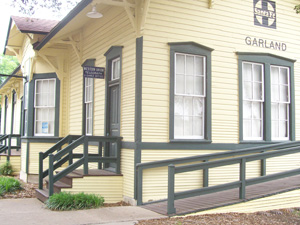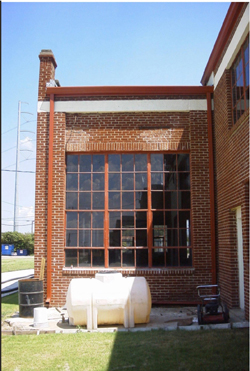Downtown Garland property owners last night learned how they could obtain federal, state and county funds for rehabilitation of their buildings, if the proposed downtown Garland listing on the National Register of Historic Places occurs.
If income-producing property owners take advantage of all the available tax credits, the listing could underwrite nearly 50 percent of the rehabilitation costs—thus raising a much-needed infusion of capital from outside the city totaling millions of dollars of upgrades in the heart of downtown Garland’s business district.
Gregory Smith, National Register coordinator for the Texas Historical Commission told property owners that for every dollar they spend refurbishing their income-producing historic buildings, they could get nearly 50 cents back in tax credits (on federal and state taxes, on state sales taxes and from reduced Dallas County property taxes). The funds could be used for new roofs, new heating and air conditioning systems, electrical and plumbing overhauls, as well as aesthetic revisions including new signage.
The tax credits could be used for any building that is deemed contributing to the historic district. In Garland 41 buildings in the 10-block area proposed for the historic district are considered contributing structures—a structure adding to the historical integrity or architectural quality of the district. Smith indicated that as years pass, other buildings within the new district boundaries might also qualify for the monies.
The listing is all but assured by as early as next summer unless 50 percent of the property owners within the proposed district send signed and notarized objection letters by Jan. 20 to the Texas Historical Commission—an unlikely feat given the enthusiasm for the project among the majority of downtown property owners. Smith said during the past 10 years, the THC has not received even one notarized letter opposing such districts—in part due to the lucrative incentives. No Garland property owner has indicated he or she will oppose the new district.
Listing on the National Register is mostly honorary unless a property owner takes advantage of the money offered.
The state’s tax credits are linked to the state franchise tax. For businesses that are not large enough to pay a franchise tax, the tax credits can be sold to investors at a discounted rate, Smith said. During the recent annual convention in Houston of the National Trust for Historic Preservation, attendees were told that currently Texas tax certificates for historical preservation sell within hours after being issued to investors on the East and West Coasts for 93 cents on the dollar.
Boundaries of the proposed Garland Downtown Historic District are Avenue A to the south, Glenbrook to the west, just beyond the Santa Fe tracks on the east and just behind the State Street-facing buildings on and near the downtown square on the north. Fifty-two buildings are included within the boundaries of the district; 41 of those are considered contributing.
The area includes a variety of buildings from the West Side’s early masonry buildings that survived the 1899 fire to the more modern style of the former Lone Star Gas Company building from the 1960s on State Street
The nomination is slated to be acted on at the Texas Historical Commission’s State Board of Review in Houston Jan. 21. City council was asked at the Dec. 13 meeting to pass a resolution supporting the nomination; several council members asked for additional clarification. The matter could come up again at the Jan. 3 regular council meeting.
Smith indicated that a letter from or a resolution by a governmental entity either supporting or opposing formation of a new National Register district would be taken into consideration but is not the deciding factor for the state or federal departments approving new historic districts.
Garland’s Travis College Hill Addition is already in line to be listed on the prestigious National Register. Its listing was approved in September by the THC’s State Board of Review, with final official federal approval expected from the National Park Service in early 2017. If the Downtown Garland Historic District is approved by the state review board in January, this would produce two such recognitions in Garland during one year.
District is approved by the state review board in January, this would produce two such recognitions in Garland during one year.
Business owner Chad Jones of the Jones Hardware family asked Smith what happens if a building is listed as contributing now but years later physical changes are made that make it no longer contributing.
“If I so choose to make changes, I don’t want to come back years later and be told, ‘You can’t do that now’,” said Jones.
Smith replied that the THC is not in the business of “de-listing” historic districts. He said “there’s no trigger”—no change made in an existing historic district that sends off an alarm at the state that a building in a district is being compromised.
“It’s not going to come from our agency,” Smith said.
He said it is presumed that over the course of time some buildings in a district will be lost, some will be rehabilitated, some will be torn down and rebuilt and new buildings will be constructed on vacant land. He said that in more than 12 years he has never had someone “petition us to de-list a historic district.”
Smith said a property owner can’t get credit for projects already completed on a building. “Come to us as soon as you have an idea” for a rehabilitation project that might qualify under the tax credits, he stated.
At the council work session Tuesday night, preservation architect Nancy McCoy told council members that the honorary recognition “doesn’t come with a lot of strings.”
“It encourages preservation but doesn’t require it. It doesn’t attempt to manage or impact disposition of property, nor does it require public access to private property,” said McCoy, whose Quimby McCoy Preservation Architecture firm was hired by the city to conduct the downtown Garland survey of historic properties in preparation for the nomination.
Don Jones of Jones Hardware asked Smith whether typically a city’s listing on the National Register is a preliminary step toward local preservation ordinances for downtown buildings.
Smith said that often local ordinances are already in place for cities at the time these are proposed for National Register status.
“I don’t know what happens afterward,” he stated. “It’s a local option. There’s not a cookie-cutter approach.”
Garland has no existing preservation ordinance; none is in the works.
“People pay attention to districts being listed,” Smith said. “We get calls from investors” because they realize that the listing makes an area more attractive for development, he noted.
McCoy told council members, “The principal impact [of a district’s being on the National Register] is heritage tourism.”
She added that a person that comes to an area for heritage tourism typically “spends more than an average tourist” in an area.
The meeting was held in the Goldie Locke Room of the Duckworth Building. Smith was part of a three-member delegation from the Texas Historical Commission in Austin on hand for the public hearing.


